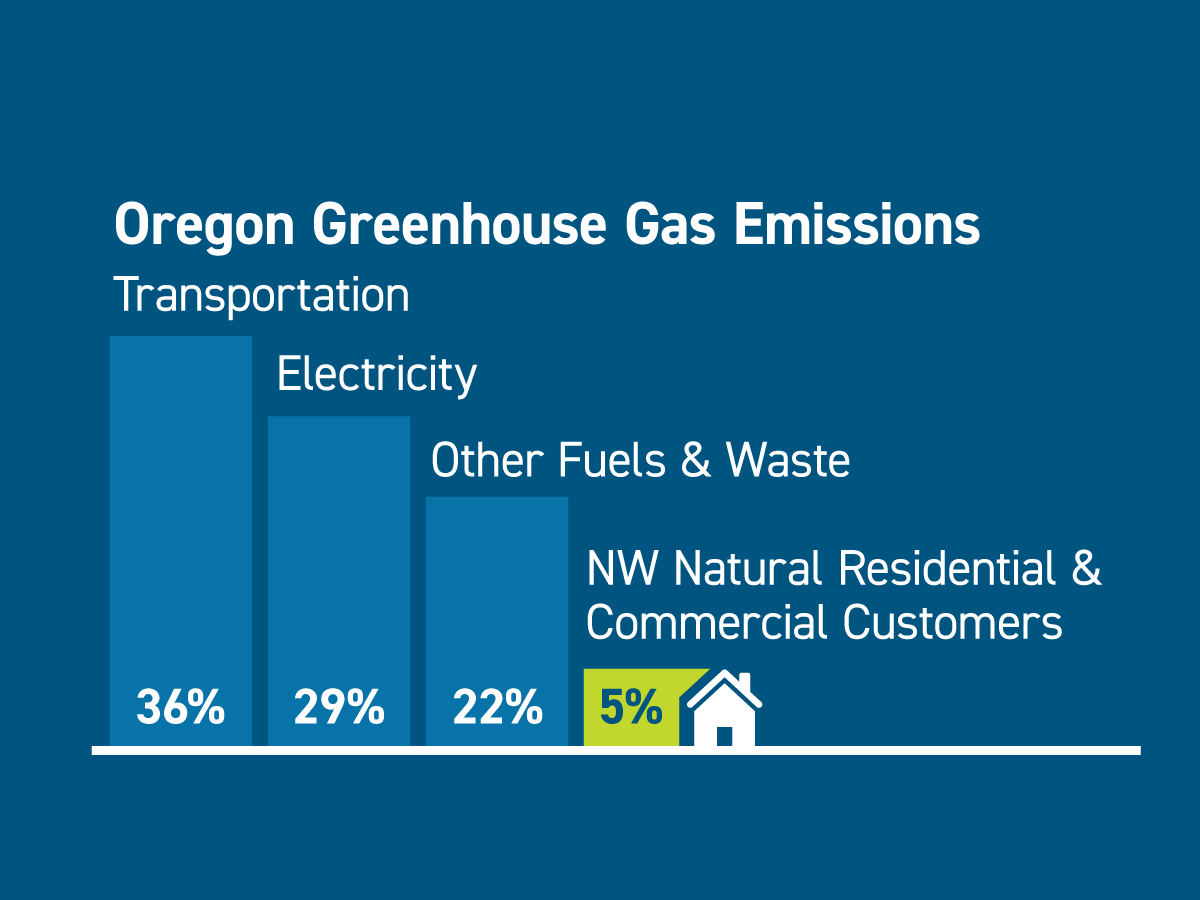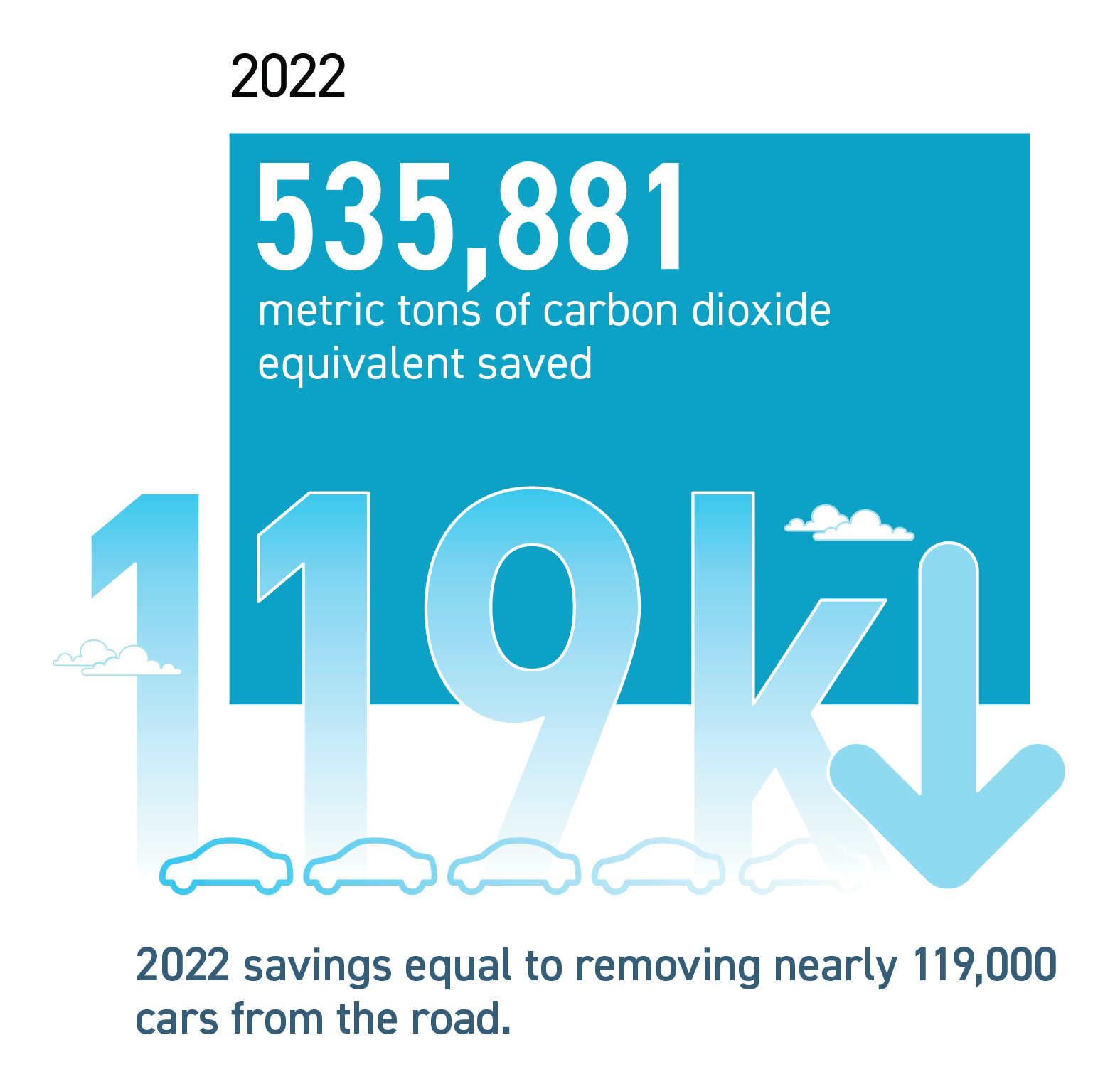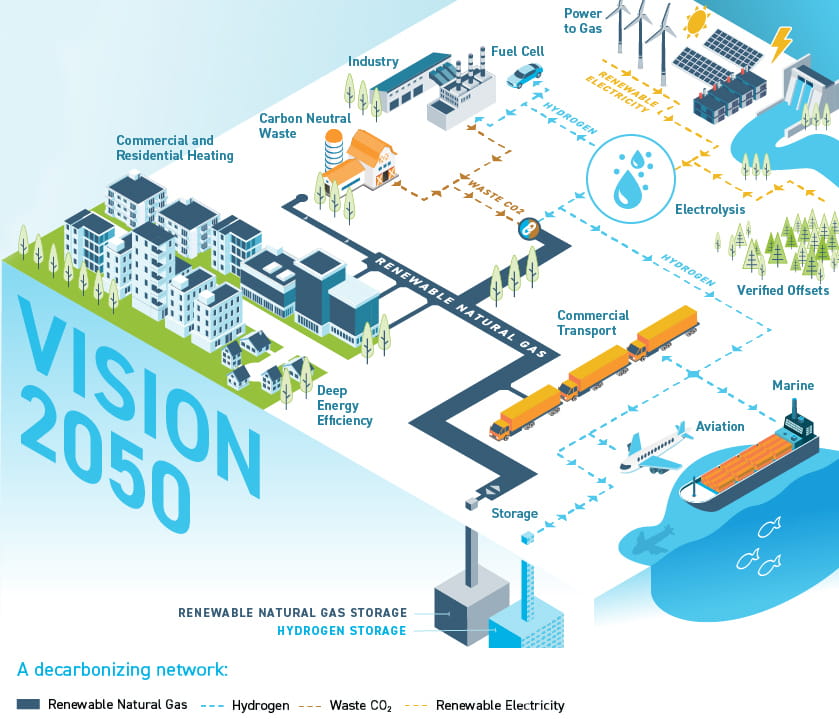Our Low Carbon Pathway
- Lowering energy use through aggressive energy efficiency and decreased consumption
- Providing customers with a voluntary program to purchase carbon offsets as an interim tool to reduce emissions
- Reducing the carbon intensity of conventional natural gas across the value chain
- Evolving our supply to include renewables in the pipelines
Today, NW Natural delivers more energy to Oregonians in a year than any other utility in the state – gas or electric.2Per data from the Oregon Public Utility Commission, 2021 Oregon Utility Statistics Book
The energy we provide to Oregonians accounts for about 5% of the state’s overall GHG emissions, compared to electricity at 29% –
and the transportation sector, which is still the largest emitting sector.3Oregon DEQ In-Boundary GHG Inventory 2021 data. Available at: https://www.oregon.gov/deq/ghgp/Pages/GHG-Inventory.aspx
Our commitment
We have a longstanding commitment to safety, environmental stewardship, and taking care of our employees and communities. Our Environmental, Social and Governance report illustrates our goals and progress around these issues like pursuing decarbonization for our gas utility, growing our water and wastewater utility business, and continuing to advance diversity, equity and inclusion in our workplace.NW Natural and its customers leading the way
NW Natural's modern system
NW Natural's modern system
NW Natural was one of the first utilities to replace all older pipes, making our system among the most modern in the U.S. An Environmental Defense Fund study led by Washington State University found that methane emissions on our system were 90% lower than EPA assumptions. This analysis shows that less than one-tenth of one percent of the gas that flows through our pipes doesn’t end up getting used by our customers, making our system one of the tightest in the nation.
Driving down emissions
Driving down emissions
While we work to add renewable natural gas to our system, NW Natural is also aggressively pursuing other emission reduction solutions:
- Replacing older pipes and equipment has resulted in an incredibly tight and efficient system that limits greenhouse gas emissions.
- NW Natural purchases natural gas from Canada and the Rocky Mountain regions—two of the most stringently regulated (i.e., minimal methane leaks) production areas in North America.5Canada's Oil and Natural Gas Producers, Environmental Action & Conservation; BC Oil & Gas Commission, Methane Reduction; Colorado Oil & Gas Association Fact Sheets
- We have developed an emissions screening tool that uses EPA data to prioritize purchases from the lowest emitting producers.
- NW Natural is a founding member of the EPA’s Natural Gas STAR Methane Challenge, designed for utilities to share emission-reducing best practices in pipeline construction, maintenance and repair.
- We are also a member of ONE Future, working to promote science-based technology and best practices for dramatically lowering greenhouse gas emissions.
Conserving
Conserving
For two decades NW Natural’s rate structure has been based on decoupling, which is intended to break the link between a utility’s revenues and the quantity of gas used by its customers, removing any financial incentive a utility might have to discourage customers from conserving energy. Today more than 75% of our gas utility revenues are decoupled.
Through our Less We Can public awareness campaign, we actively encourage customers to use less energy.
Using efficient equipment
Using efficient equipment
We are working to encourage the development of progressive technologies that use less energy. Through our partnerships with the Gas Technology Institute, Low Carbon Resources Initiative and Northwest Energy Efficiency Alliance we seek to transform the market for innovative products. We co-founded the North American Gas Heat Pump Collaborative with local distribution companies across North America to support the adoption of highly efficient space and water heat equipment that are designed to reduce carbon emissions. Gas-powered heat pumps offer the opportunity to reduce natural gas consumption while maintaining equipment performance in cold weather—a challenge for electric heat pumps. Gas heat pumps are expected to be commercialized and available beginning in 2023. Research indicates that new technologies like these have the potential to reduce energy use by 40% or more in the residential sector.7Opportunities for Reducing Greenhouse Gas Emissions Through Emerging Natural Gas Direct-Use Technologies. An American Gas Foundation report prepared by Enovation Partners, 2019
Offsetting
Offsetting
NW Natural was the first stand-alone gas utility in the U.S. to offer customers a voluntary program that allows them to offset carbon emissions from their natural gas use. Launched in 2007, our Smart Energy program purchases carbon offsets from projects that sequester, reduce and prevent the release of greenhouse gases. Many of these projects are biodigesters on family-owned dairy farms. The program’s mantra, “Use Less, Offset the Rest,” reflects our conviction that verifiable offsets are a valuable tool for effectively lowering emissions.
In 2021, we added renewable natural gas (RNG) to the program for our Washington customers. That gives them a new mitigation resource and aligns with recent legislation that requires natural gas companies in Washington to offer by tariff a voluntary RNG service.
In 2021 Smart Energy enrollments increased by nearly 20% and now more than 10% or nearly 75,000 of our residential customers are enrolled in the program. They funded over 197,000 metric tons in emission reductions, equivalent to removing over 42,000 cars from the road in 2021. That made Smart Energy the second largest contributor to our low-carbon goal NW Natural set in 2016 and accounted for nearly 188,000 metric tons of savings toward the goal in 2021.
Renewable natural gas future
Renewable natural gas future
Studies have shown that natural gas and the gas pipeline network will be needed for the Pacific Northwest to achieve its climate goals. A report by the premier environmental consultant Energy and Environmental Economics (E3) outlines how our system—leveraging renewables developed for the pipeline—can be instrumental in achieving deep decarbonization in our region most affordably and reliably.8Independent consulting firm Energy and Environmental Economics (E3) study published in December 2018 and commissioned by NW Natural
- RNG can reduce greenhouse gas emissions, and it is interchangeable with conventional natural gas, so RNG can be added directly into existing gas pipelines
- RNG can be stored for distribution on demand, and the supply of waste doesn’t fluctuate the way weather-dependent renewable energy sources do
- RNG can replace diesel fuel in transportation to reduce emissions and improve local air quality
Pacific Northwest Pathways to Decarbonization
Oregon and Washington have set goals for steep greenhouse gas emissions reductions, as part of an economy-wide effort to combat climate change.
These kinds of goals are referred to as “deep decarbonization” and mean an 80% reduction in carbon emissions by 2050 from a 1990 emissions baseline – even after factoring in population growth. Is this possible? And if so, how?
A new report, Pacific Northwest Pathways to 2050, by Energy and Environmental Economics (E3), shows how the natural gas system can help the region get there.



